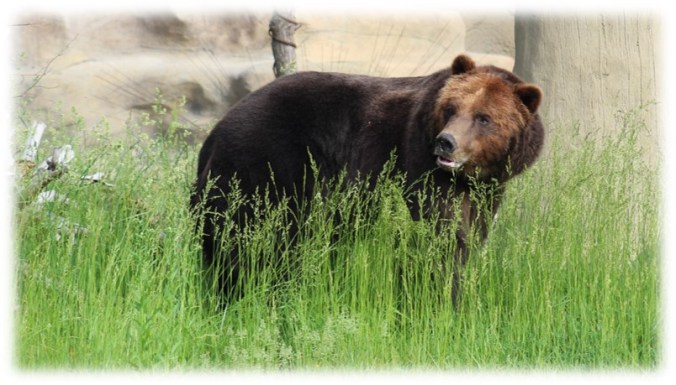As part of the Detroit Zoological Society’s (DZS) commitment to ensuring individual animals experience great welfare, a significant expansion of the grizzly bears’ habitat was undertaken in 2018. The male grizzly bears living at the Detroit Zoo, Mike, Thor and Boo, are brothers who were rescued in Alaska after their mother was killed and the cubs began foraging too close to humans. At approximately one year of age, they were too young to properly care for themselves and the DZS provided them with a safe place to grow up. The bears are now eight years old and weigh approximately 900 pounds.

The expansion doubled the amount of space for the bears and also increased the number of environmental features in the habitat, including caves and substrates such as grass and mulch. When we make changes that affect the lives of animals, it is important that we understand how those changes impact them. To that end, we collected data the fall prior to construction to obtain a baseline of the bears’ behavior and hormone levels. Observations continued during construction and ended two months after the bears moved back into their renovated home. Zookeepers also filled out surveys and collected fecal samples each day.
We were happy to see that, in general, the construction itself had little impact on the bears. We had the zookeepers keep track of things like appetite and interest in participating in positive reinforcement training, and the bears did not show any changes to these behavioral indicators of welfare. Additionally, their glucocorticoid concentrations did not change during construction, suggesting that the bears did not perceive this to be a stressful time period. We did see some fluctuation in how much time each bear was visible outside, depending on how loud the construction activities were. Only one of the bears, Mike, spent more time inside (and out of sight) when the construction noise reached higher levels. Individual animals, just like people, perceive experiences differently, and therefore may react differently.
When we compared how and where the bears spent their time before and after the expansion, we had some interesting results. The bears made use of all of the substrates and features in the expanded habitat. They were very excited to gain access to a mulberry tree that had previously been part of one of the side bear habitats. Mulberry is enjoyed by many species at the Detroit Zoo and the grizzly bears are no exception. Mike very industriously spent time trying to uproot the tree to make it easier to eat all the delicious berries! All three bears also enjoyed digging up, excavating if you will, various sections of the habitat. One thing that did not change was Thor’s affinity for his rock “pillow”. There is a large boulder-sized rock formation high up in the original habitat space on which you can sometimes find him resting his head. Thor still very much enjoys giving the rock a bear hug as he catches up on some sleep!

Not only did the expansion mean the bears had more environmental choices, but the additional features had an impact on their social dynamics as well. With more space and more options within that space, the bears could spread out and all spend time in areas that met their needs, rather than sharing, or having to wait to use the features. This also translated into even more positive relationships between the brothers. We did see Boo practice his best “little brother” moves in the expanded habitat. He will come as close to Mike as possible until Mike finally swats or chases him away. I definitely experienced that with both of my little brothers growing up! It is possible that with more space, Boo enjoys getting a reaction from Mike and having plenty of room for the game of “catch me if you can” that may follow.
The expanded space has given the grizzly bears more behavioral opportunities and the ability to make more choices about how and where to spend their time, as well as how much of that time they want to spend near one another. The DZS is always striving to create habitats that promote great welfare and increased choice is an important part of that.
– Dr. Stephanie Allard is the director of animal welfare for the Detroit Zoological Society and oversees the Center for Zoo and Aquarium Animal Welfare and Ethics.
I always enjoy visiting the bear exhibit when I’m at the zoo; the brothers are almost always up to some interesting antics. It’s nice to know they’re enjoying their expanded habitat.
>Mike very industriously spent time trying to uproot the tree to make it easier to eat all the delicious berries!<
LOL!